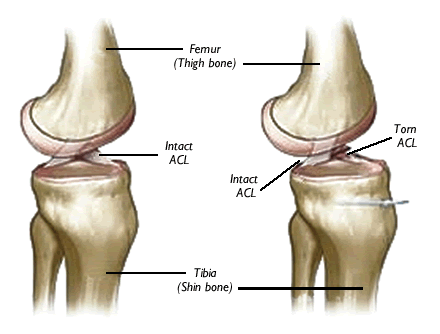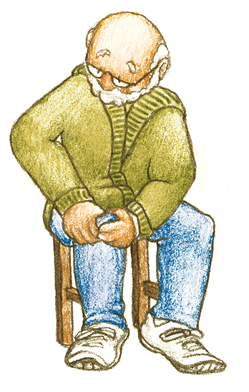Sinus Surgery Cutting Edge Technology
Troy Berg, MD
Orthopedics
Chippewa Valley Orthopedics & Sports Medicine
Eau Claire
A one and one-half inch bundle of connective tissue has become a household term and an important part of our active culture. An injury to this structure can change a person’s career, and even alter the fate of a sporting franchise. What is it and why is it so important?

It is the ACL and an injury to it can dramatically affect a person’s ability to run, jump and twist. ACL stands for anterior cruciate ligament. Humans have four main ligaments in their knees – the collateral ligaments (medial and lateral) and the cruciate ligaments (anterior and posterior). As shown in this diagram, the ACL runs from the back of the femur (thigh bone) to the front of the tibia (lower leg bone). It thus prevents the tibia from slipping forward on the femur. It also courses somewhat diagonally and thus prevents the tibia from rotating abnormally on the femur.
ACL injuries occur in one in every 1,750 active persons per year. The injury typically occurs from a violent, twisting motion such as when landing from a jump, or suddenly changing direction. When compared sport for sport, hour for hour, females tear their ACLs four to seven times more commonly than males. There are several reasons for this, including anatomical differences, variations in hormones, and, most importantly, strength issues. Fortunately, strength is something that can be modified through training; and specialized conditioning programs have been shown to decrease the incidence of ACL tears.
 People with ACL tears will often feel their knee give way when running, twisting or jumping. The knee can also give way with less strenuous activities, such as walking on uneven ground. When the knee gives way, or pivots, it is painful and can cause damage to the cartilage in the knee. Indeed, studies have shown that the incidence of meniscal tears (the shock absorbing cartilage in our knees) increases the longer a person goes without their ACL.
Young, active individuals tend to have more symptoms from an ACL tear than older, more sedentary people. Not everyone with an ACL tear will need surgery for it. Some individuals simply do not have symptoms of instability, others modify their activity and thus avoid instability, and some are able to control the symptoms with exercises and the use of a brace.
People with ACL tears will often feel their knee give way when running, twisting or jumping. The knee can also give way with less strenuous activities, such as walking on uneven ground. When the knee gives way, or pivots, it is painful and can cause damage to the cartilage in the knee. Indeed, studies have shown that the incidence of meniscal tears (the shock absorbing cartilage in our knees) increases the longer a person goes without their ACL.
Young, active individuals tend to have more symptoms from an ACL tear than older, more sedentary people. Not everyone with an ACL tear will need surgery for it. Some individuals simply do not have symptoms of instability, others modify their activity and thus avoid instability, and some are able to control the symptoms with exercises and the use of a brace.
ACL surgery typically involves replacing the ligament with a substitute (ACL reconstruction). In the distant past, surgeons attempted to repair the ACL (sew the torn tendon back together), but the ACL does not have a good blood supply and these repairs typically did not heal. In the 1980s there were attempts at using artificial ligaments made from materials such as Gortex. These also tended to fail as they did not have the resiliency necessary to hold up to the repetitive forces in the knee.
The most successful treatment has been found to be reconstructing the ACL with a graft (borrowing a tendon or ligament from another area). There are a variety of graft choices available including autograft (from the patient) or allograft (cadaver tissue).
For autograft tissue the two main graft choices are patellar tendon versus hamstring tendon. There are reasons and advantages to each particular graft, and treatment is tailored to the individual. Hamstring tendon autograft is becoming increasingly popular, largely because of superior biomechanical properties.
In summary, ACL tears are common. A dedicated strengthening and conditioning program can lower an athlete’s risk of sustaining an ACL injury. Finally, if you do injure your ACL there are many treatment options available to keep you and your knee healthy and active.
Dr. Berg – Chippewa Valley Orthopedics & Sports Medicine
For information or to schedule an appointment:
715.832.1400 | 800.322.1747 | cvosm.com
Dr. Berg sees patients in Eau Claire, Chippewa Falls, Cumberland,
Rice Lake and Shell Lake.





 © 2009 OakLeaf Medical Network and OakLeaf Surgical Hospital. All rights reserved.
© 2009 OakLeaf Medical Network and OakLeaf Surgical Hospital. All rights reserved.